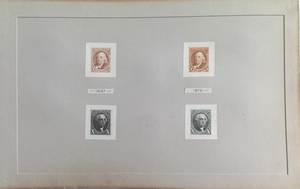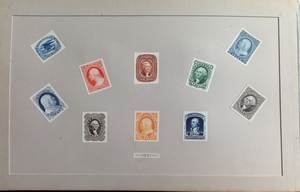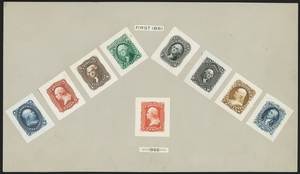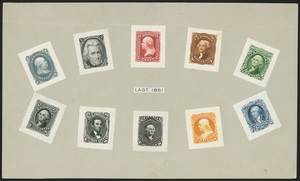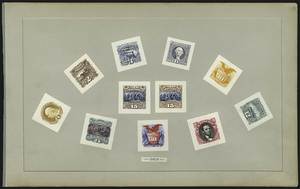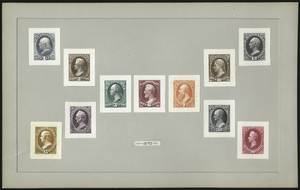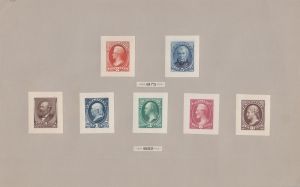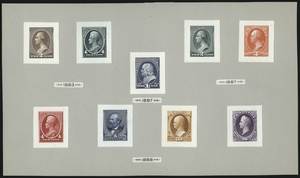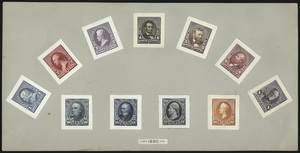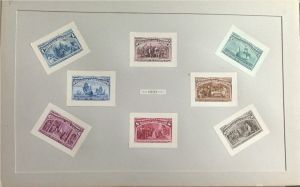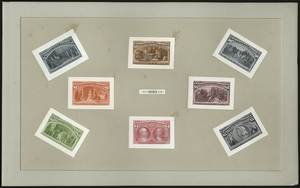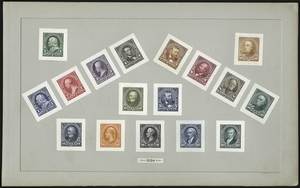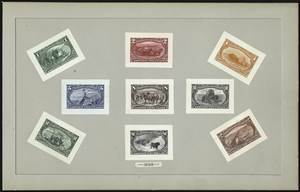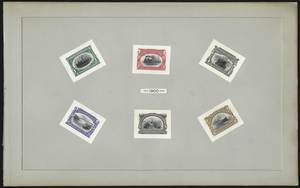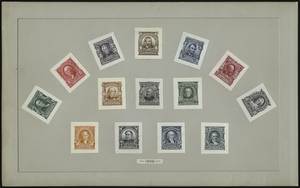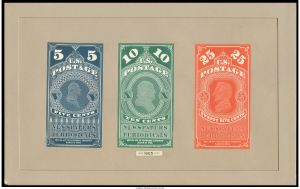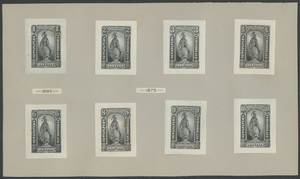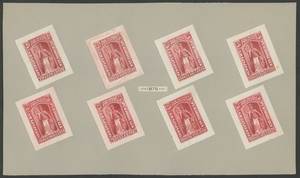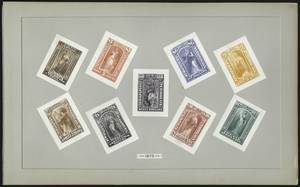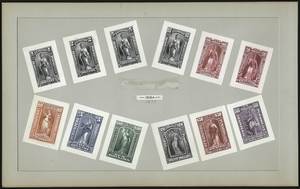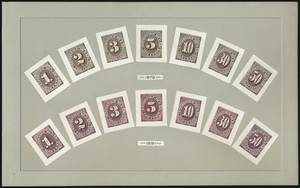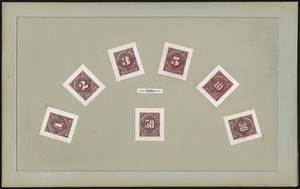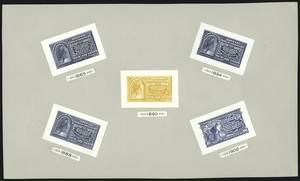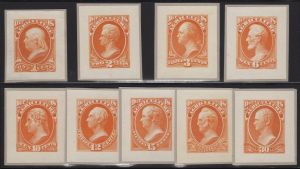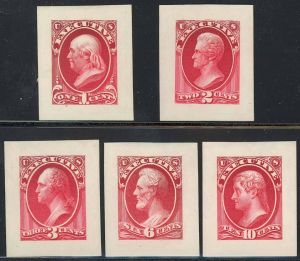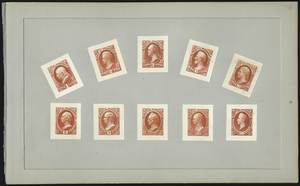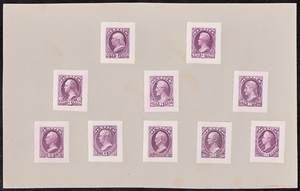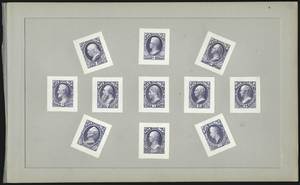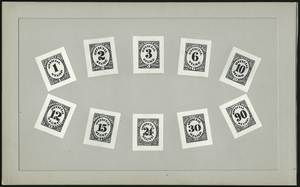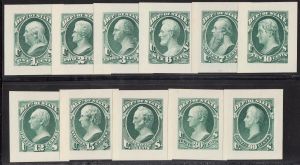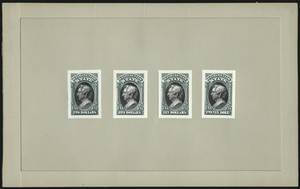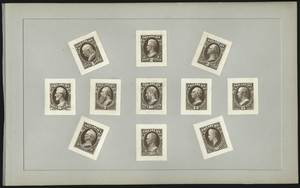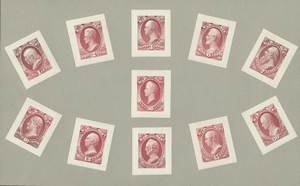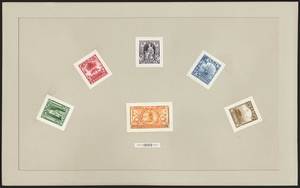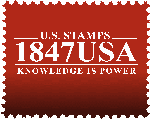Roosevelt Proofs
By Richard Segal
last update April 7, 2017
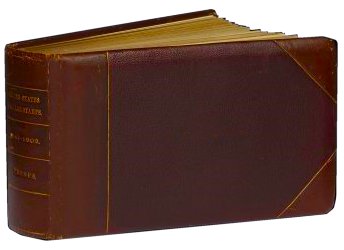
Roosevelt Presentation Album
Roosevelt presentation albums were produced in early 1903 and contain die proofs of stamps meant to represent all the stamps issued by the United States Post Office until that time. They were produced by Third Assistant Postmaster General Edwin C. Madden using original dies from the Bureau of Engraving & Printing and given as gifts to influential friends of President Teddy Roosevelt and a very select few others. Only 85 albums were produced.
As collectors of U.S. classic stamps know, there were many varieties of stamps printed from 1847 to 1902 and we love to collect them all. In the Roosevelt album there are only 308 die proofs, far fewer than are collected by philatelists. This article is an attempt to inventory those 308 proofs and clarify what is and what is not truly a Roosevelt Proof and explain any differences between that inventory and what we know about the original stamps.
There are other articles available on the internet on the history of these albums which may also make for fascinating reading. Because of their rarity and beauty, Roosevelt die proofs are highly collectable and sell at a premium. There are but a handful of complete albums still in existence and when one comes up for auction it is a rare event indeed.
One final note of introduction. Taking apart one of these albums is an extraordinarily difficult task. Each two-sided gray card must be split down the middle without damaging the stamps. Removing a stamp from the gray card on which it is mounted often results in thins and discoloration. For that reason you will see many of these proofs for sale still on the original gray card backing. Removing them is not advised for anyone but an expert.
Notes about the images:
Click on the pictures to the to see the full-sized image.
The author of this article did not have access to a complete Roosevelt Presentation Album. The images were found online for most pages and an attempt has been made to put the images in a sensible order; however, this is not the same order as they appear in the album.
Where no full page image was found, images of the cut down proofs are shown. When the full page image is not of good quality (first two pages) you can click on the image to see images of the individual cut down proofs.
Images of all 308 proofs are included.
The First Issue
The first stamps issued by the United States Post Office were produced by Rawdon, Wright, Hatch & Edison in 1847. The Bureau of Engraving & Printing wasn't established by Congress until 1874. In 1875-6 they issued reproductions of those first stamps from new dies. They looked almost the same, but were not identical to the original stamps. The reproductions were not valid for use as postage. When the Roosevelt albums were constructed, it was only those reproduction dies that were available. Collectors were well aware of the differences, and so there was a dilema regarding how to create proofs for the two sets of stamps. There is conflicting information about this; however, the leading theory is as follows. The two stamps labelled 1847 were produced directly and as accurately as possible from the reproduction dies. The 1876 labelled stamps were produced from those same dies but shifted so as to produce a fuzzier image resembling that of a double transfer - a stamp where parts of the image have been doubled or shifted in some way. The Scott catalog does not, as of this writing, distinguish between these two sets of stamps. They are both listed as 3P2 for the 5 cent and 4P2 for the 10 cent proof. Nonetheless there are clearly differences between the two sets. Click on the picture to see more detailed images of both sets.
1851-1860 with help from 1875
Starting in 1851 a series of eight portraits, five of Washington, two of Frankln, and one of Jefferson were used on multiple waves of stamp production. Each portrait kept the same stamp design - more or less - throughout the period through 1860. Reproductions of the eight designs were produced in 1875 with slight differences. The reproductions were not valid for postal use. The Roosevelt album only includes one example of each stamp design. The designs look a lot like the reproductions but with one notable exception. The original design of the 5 cent Jefferson was a tall stamp which made it hard for printers to fit the entire design onto each stamp when perforations were added starting in 1857. Later versions of the design were modified to cut out the protruding top and bottom parts of the design to better fit. This pattern was continued with the later reproductions. The Roosevelt stamp however, returned to the original design including the protrusions. The eight proofs are numbered in Scott as 40P2-47P2 using the same numbering scheme as the 1875 reproductions. Also on the page marked 1851 are proofs of two Carrier's stamps originally printed in that year. Carrier's stamps were used to move mail between post offices.
1861
In 1861 a new series of stamps was introduced. The first versions were not used as postage and were produced in very small quantities. These are known as the "first design" or "premiere gravure" stamps and typically sell for much higher amounts than the later regular printings. The first 1861 page in the Roosevelt album is intended to represent those stamps but the original dies were not available so dies, sometimes modified to look like the first designs had to be used. The second page represents the regular stamps. Two new presidents are added: Jackson and Lincoln. An additional complication comes from a change made by the Scott catalog which originally numbered the early stamps as numbers 55 through 62 and later changed them to show them as essays or trial color proofs (see table below). A special section can be found in the Scott Specialized Catalog of U.S. Stamps between Essays and Proofs dedicated just to this set of highly valued Premiere Gravure stamps.
A final confusion is regarding the 3 cent stamp. There are two on page 1 and one on page 2. Scott lists five 3c Roosevelt Album proofs with colors Pink (64P2), Rose (65P2), Lake (66TC2), Scarlet (74TC2), and Deep Red (65-E15d). Since each album only has three this is either an error or there are color variations between the albums. The first stamp on page 1 is generally considered the Deep Rose stamp intended to represent the first design. In the images shown here we would speculate that the second stamp on page 1 is Scarlet and the stamp on page 2 is Lake.
1861 Page 1 Details
The 1c stamp uses same die as regular stamp, not matching the appearance of the premiere gravure stamp. The color is darker, described as Indigo, rather than the Blue of page 2 and the regular stamp.
The first 3c stamp looks similar to the premier gravure design; however, according to Scott, this was made from the regular stamp die which was modified to remove the outer scrolls which were replaced by scrolls similar to the first premier gravure design.
The 5c stamp looks similar to the premier gravure design; however, according to Scott, this was made from the regular stamp die which was modified to remove the outer scrolls which were replaced by scrolls similar to the first premier gravure design.
The 10c premier gravure stamp was used as postage and so does not get relegated to be an essay or trial color proof. However the stamp designs shown on both Roosevelt pages is type 2 corresponding to the later regular issue Scott #68. The stamp on page one is Dark Green while the stamp on page two is just Green so Scott assigned them two distinct numbers, 62BP2 and 68P2.
The 12c stamp looks similar to the premier gravure design. Scott does not make a comment similar to that made for the 3c and 5c stamps; however, it seems likely that this is a similar case of use of a modified regular stamp die.
There was no change made to the die of the 24c stamp when used for the regular issue. The only way to differentiate the first design from the later design is by color with the first design a dark violet and the regular design in a variety of other shades. In our images, the page 1 stamp appears lighter than the page 2 stamp. Scott does not differentiate between the two calling them both lilac and both numbered 78P2.
There was no change made to the die of the 30c stamp when used for the regular issue. The only way to differentiate the first design from the later design is by color with the first design called Red Orange and the regular stamp as just Orange. In the images here the two stamps are distinctly different shades, nonetheless Scott does not differentiate between them only listing 71P2 as Orange.
The 90c first design has a few differences from the later design; however those are not evident here. Both stamps use the later design die and appear to be the same color. Essentially the same stamp appears on both pages. Strangely Scott lists two numbers, an essay 72-E7c and a proof 72P2 with different values. Perhaps there are differences to be found in other versions of the album?
| Stamp | First Design old | First Design new | Proof page 1 old | Proof page 1 new | Proof page 2 |
|---|---|---|---|---|---|
| 1c | 55 | 63-E11e | 55P2 | 63-E11b | 63P2 |
| 3c* | 56 | 65-E15h | 56P2 | 65-E15d | * |
| 5c | 57 | 67-E9e | 57P2 | 67-E9b | 76P2 |
| 10c | 58 | 62B | 58P2 | 62BP2 | 68P2 |
| 12c | 59 | 69-E6e | 59P2 | 69-E6b | 69P2 |
| 24c | 60 | 70TC6 | N/A | 78P2 | 78P2 |
| 30c | 61 | 71TC6 | N/A | 71P2 | 71P2 |
| 90c | 62 | 72-E7h | 62P2 | 72-E7c or 72P2 | 72-E7c or 72P2 |
*first 3c stamp on upper left of page 1 - see notes above regarding other 3c variations
1869 Pictorial Series
THe 1869 series includes the first stamps with pictures other than dead statesmen. The die proofs made a beautiful addition to this short-lived series. The Scott numbers are 112P2-122P2.
Large Banknotes
In 1870 the post office quickly reverted to pictures of statemen. These stamps were initially printed by the National Bank Note Company. Then in 1873 the same designs, often with tiny secret marks added, were printed by the Continental Bank Note Company. The Continental was taken over by the American Bank Note company in 1879. In many cases the stamps were unchanged in design but in some cases colors were adjusted and some new designs were added over time. Philatelists look at some aspects of the regular stamps such as grills and types of paper to tell the difference between waves of Bank Notes. No grills were added to the Roosevelt proofs and only one type of paper is used throughout, so those differences are not relevant here. No attempt was made to capture subtle color differences here either. For example no attempt was made to render both the Carmine of Scott #155 and the Rose Carmine of Scott #166.
With the exception of the 1 cent stamp the 1870 page proofs were produced using the dies of the Continental and American Bank Note Companies which included the tiny secret marks. The 1 cent stamp was produced from a new die. Scott labels that stamp as 145P2. The remaining stamps on that page are numbered 157P2-166P2. The colors are described as matching the colors of their corresponsing regular issue - for example, Rose Carmine for 166P2.
The Scott numbering for the remaining pages attempts to match the color to the oriignal issues. The dates on the page don't always match the dates of the original stamp issue. For example, the stamps labeled 1875 use the 1879 colors. Here is the complete list of Roosevelt proofs on pages 2 and 3 and the matching color descriptions.
Second Page: 183P2 - 2c Vermillion, 185P2 - 5c Blue, 205P2 - 5c Yellow Brown, 206P2 - 1c Blue, 207P2 - 3c Blue Green, 208P2 - 6c Deep Rose, 209P2 - 10c Brown
Third Page: 210P2 - 2c Red Brown, 211P2 - 4c Green, 212P2 - 1c Ultramarine, 213P2 - 2c Green, 214P2 - 3c Vermillion, 215P2 - 4c Carmine, 216P2 - 5c Indigo, 217P2 - 30c Orange Brown, 218P2 - 90c Purple
Small Banknotes
The next series of stamps produced by the American Bank Note company are sometimes described as the small banknotes. There is no complication here. The proofs match the numbering of the original and use the same dies. The number are 219P2-229P2.
Columbian Exposition Issue
The final set of postage stamps by the American Bank Note Company were issued to commemorate the Columbian Exposition held in Chicago in 1893. These were the first commemorative stamps issued in the United States. These beautiful proofs are faithful to the originals and are numbered 230P2-245P2.
First Bureaus
In 1894 the job of stamp production was turned over to the Bureau of Engraving & Printing. In the first stamps issued, the design of the small Bank Notes was reused, but with the addition of two triangles in the top corners. Variations in the designs include small differences in the appearance of those triangles and a new set of colors used starting in 1897. There are also specific design differences in the 10 cent stamp and the 1 dollar stamp.
In the Roosevelt album not all those variations exist and there is some mystery about the color changes for the 6 cent stamp.
Two cent variations: In the regular postage stamps there are three triangle types. The type shown here is type 1, where the lines pass directly through the triangle design unchanged. Scott includes an entry for the type 2 trangle stamp version, number 251P2. The 2016 Scott catalog includes this comment: "The existence of 251P2 has been questioned by specialists. The editors would like to see evidence that the item exists." As of this time I am not able to provide such evidence. There is no indication of there being a type 3 Roosevelt proof.
One dollar variations: The variation in the Roosevelt album is type 2 - as in Scott #261A and so the proof is correspondingly numbered 261AP2.
Ten cent variations: The original green 10c and one of the later brown 10c stamps (282C) are type 1. The brown 10c type 2 stamp is Scott# 283. Both the green and brown Roosevelt proofs are type 2.
The surprising three cent purple variation.: In the regular issue, the triangle variations only appear in the two cent stamp. In the Roosevelt album the 3c purple stamp has a type 2 triangle. As a result Scott has assigned number 253aP2 to the proof stamp. There is no regular issue of 253a.
Color differences:
There is only one 4c stamp in the album. The later Rose Brown version is not included.
The six cent color mystery: The is only one 6c cent stamp in the album. Scott refers to it as #256P2 - Brown. A proof corresponding to the later Lake 6c (Scott 282) does not appear in Scott; however, in our images the 6c stamp looks closer to Lake or perhaps Claret (a variation of Scott 282) than it does to brown. A fair number of stamps have come to market, in online markets like eBay, selling as 282P2 and with the same color seen here, even though that number does not exist in Scott. The author is aware of one stamp sold as 256P2 which appears brown. So it is possible that some versions of the album printed the stamp in brown and some in the color that appears here - Lake or Claret. Perhaps Scott will need to add 282P2 in the future.
The full list of Scott numbers for this page as currently recorded in Scott (not including 251P2 or the not as of yet defined 282P2):
247P2 1c blue, 250P2 2c carmine, 253aP2 (triangle type 2), 3c purple, 254P2 4c dark brown, 255P2 5c chocolate, 256P2 6c brown (color mismatch), 257P2 8c violet brown, 258P2 10c green (but type 2), 259P2 15c dark blue, 260P2 50c orange, 261AP2 $1 black, 262P2 $2 dark blue, 263P2 $5 dark green, 279P2 green, 281P2 5c blue,, 283P2 10c orange brown, 284P2 15c olive green.
Trans-Mississippi Exposition
The Roosevelt proofs match the regular issue. Scott numbers are 285P2-293P2.
Pan-American Exposition
The Roosevelt proofs match the regular issue. Scott numbers are 294P2-299P2.
Newspaper Stamps
Newspaper stamps were issued from 1865 through 1898. They were used as postage on bulk shipments of newspapers. The stamps were often colorful and depicted statues representing concepts such as Freedom, Justice, and Peace as well as mythical gods including Clio, Minerva, and Vesta. They were issued in several versions through to 1894 and then a new version of the statue designs was used starting in 1895.
The Scott catalog numbering is straightforward except for the very first stamp which is closer in color to PR4 which is light blue, than it is to PR1 which is dark blue.
Page 1 numbering: PR4P2, PR2P2, PR3P2
When the series of black stamps shown on the second page were issued in 1875 there was no one cent stamp included. This was introduced in 1885. Thus the Scott numbering for this page is PR81P2 followed by PR9P2-PR15P2.
The third page of Rose colored stamps are in order as PR16P2-PR23P2.
The fourth page continues in order of increasing denomination from PR24P2-PR32P2.
The designs shown on the last page (on which someone wrote in the correct year of 1895) proceeds in order from PR102P2-PR113P2.
Postage Due
THe three sets of proofs here are straightforard representations of the original brown (J1-J7P2), bright claret (J22-J28P2) series skipping only the red brown series of 1884. THe second page is a reproduction of the deep claret series of 1894 (J31-J37P2).
The only mystery here revolves around a set of Parcel Post Postage Due proofs that Scott records with a date of 1912 and catalog numbers JQ1P2-JQ1P5. The Scott catalog states "Specialists have questioned the existence of genuine examples...". Research recorded in the paper: United States Parcel Post System Postage Due Stamps and Proofs by Harry K. Charles Jr. in the National Postal Museum includes the following paragraph also indicating that no such proofs have been found: "The first of the small die proofs is listed by Scott as JQlP2 to JQ5P2. Since the Parcel Post Postage Due stamps were not developed or in use until the 1912 to 1913 time frame, these small die proofs are obviously not from the so called Roosevelt Albums which were produced in 1903. A careful inspection of the Southgate Collection sold by Brazer in the early 1940's did not contain such a set of proofs. A similar statement can be made about the auction of the Roosevelt Collection in 1946. They also were not part of the Hackett or Cromwell sales in the 1950's. In fact a careful examination of major auction catalogs over the last fifty or so years has failed to yield any reference to such proofs. The author wonders if they exist and would appreciate any available information about these proofs."
Special Delivery
The Special Delivery proofs are straightforward reproductions of the three blue E1P2-E3P2, one orange, E4P2 and one untramarine, E6P2 special delivery stamps issued between 1885 and 1902. (E5 is the same design as E4, but watermarked.)
Official Stamps
THe Roosevelt proofs for the Official stamps are straightforward reproductions of the original stamps. The stamps are shown here in the order listed in Scott. They have catalog numbers O1P2-093P2.
Cuba
The United States issued stamps for Cuba after the Spanish-American War and during the United States' military occupation of Cuba. The stamps represented by proofs included in the Roosevelt album were printed by the Bureau of Engraving & Printing. The proofs are numbered by Scott as 227P2-231P2 and E3P2.
